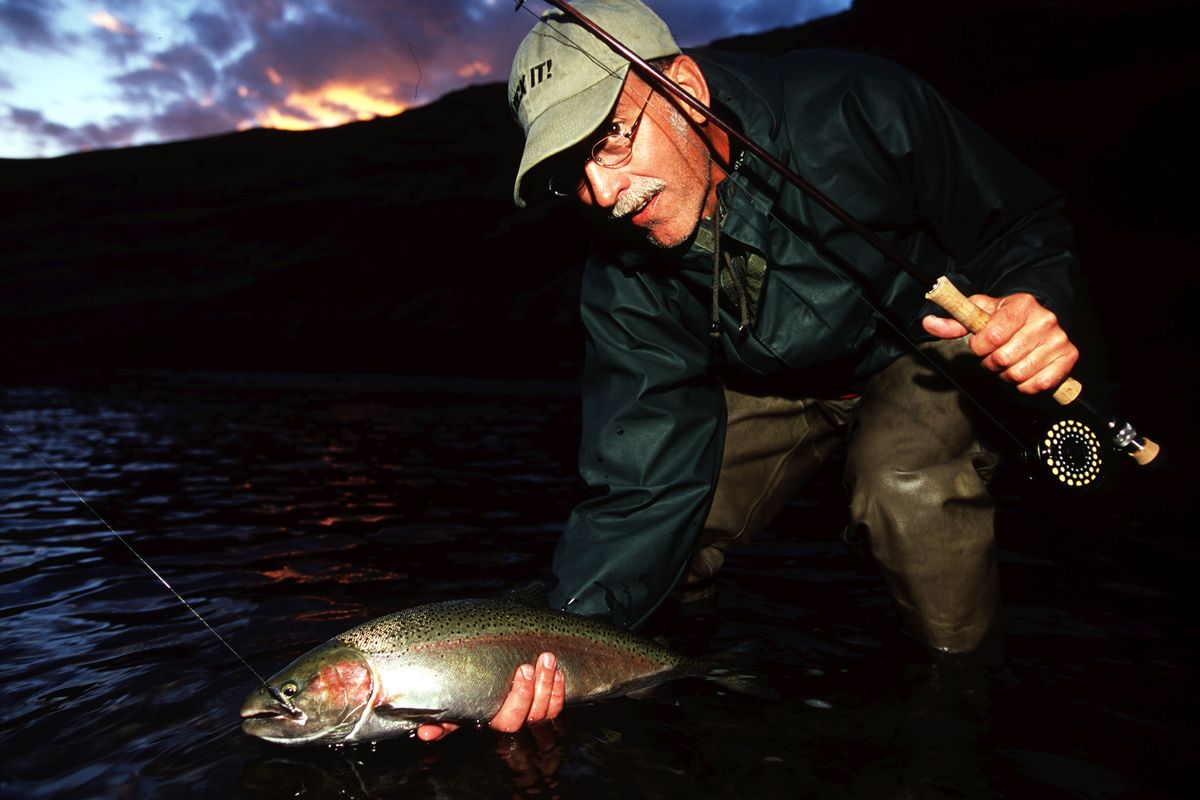Rig for a record run
Different strokes catch fish for different folks

Of all the steelhead fishing techniques, none is quite so simple as the cast-swing-step rhythm of fishing a fly.
The fish-catching part isn’t always so easy, but the method is free of trolling motors, messy cured eggs, fish-finders and expensive plugs.
“If you can catch trout, you can catch steelhead,” Sean Visintainer of Silver Bow Fly Shop said last week. The young guide and shop owner was speaking to a crowd of Spokane fly fishers eager to get up to speed for this year’s record run of Snake River steelhead.
Then he gave them basic guidelines for hooking up with the big ocean-running rainbows in the Snake, Clearwater and Grande Ronde rivers.
A 7-weight fly rod or possibly an 8-weight is ideal in these rivers, he said: “Make it 9 to 10 feet long to get good mends. It should be fast-action with plenty of backbone for handing these fish.”
The reel should have a good drag or frame for palming and capable of holding 125-150 yards of backing. “Go for 30-pound backing,” Visintainer said. “It doesn’t cut your fingers so much as 20-pound when these fish rip out line.”
Floating and sinking-tip lines are his workhorses, with powerful leaders to help turn over the bigger steelhead flies. He uses tippets size 2X, 1X and 0X. Leader lengths are 9-12 feet for floating lines and 2-4 feet for sink-tip lines.
Flies range from traditionals such as variations of the Skunk pattern to weighted leeches such as the Intruder as well as egg patterns, stonefly nymph patterns and large variations of the Prince Nymph.
As for all the theory about when to fish dark- and light-colored flies, “I haven’t found a lot of rhyme or reason to it,” Visintainer said.
And while some anglers have been trying to beat this year’s crowds by getting on the river at 5 a.m., “It’s not uncommon for us to catch most of our fish in the middle of the day,” he said.
Water clarity and temperature are among the most important variables.
“A pulse of water in the river is good for getting fish moving and biting,” he said. “But too much rain will blow out the river for days.”
Randy Shaber, an ardent Spokane fly angler with many years of experience on the Grande Ronde and other rivers, said steelheading can be good even in cold-water temperatures.
“The key is temperature change,” he said. “Fish are cold-blooded and they adapt to cold water. But a sudden drop will chill them out. A rise in cold temperatures, however, can turn them on.”
In fall water temperatures, Visintainer looks for fish in faster water, mostly with floating lines, making casts quartering downstream and letting the fly swing across toward shore.
Tip: Always let the fly hang directly downstream for a few seconds before retrieving. It can trigger a strike.
During winter, he concentrates on the slower stretches where steelhead hole up, casting nearly perpendicular across the stream and letting it swing. He’ll use sinking-tip or full sinking lines while swing-fishing in cold water that drives the fish to the bottom.
Sometimes he mends after the cast to form a “Lazy J” in the line so the fly is angled broadside to the current as it sweeps down and across.
“This presents a profile of the fly to the fish instead of the butt end,” he said.
“Be in contact with the fly as soon as it hits water. Fish often strike the fly within a second or two. If your line is slack, you’ll miss the strike.
“For the same reason, mend by lifting the rod and moving a little line to avoid losing tension. Don’t throw a bunch of slack.”
River etiquette calls for taking a few downstream steps between each cast as you “sweep” through a run so other anglers can step in and work down behind you.
If everyone practiced that etiquette, anglers would rotate through runs like clockwork.
Nymphing is an effective steelheading technique, he said.
“I rig with a big indicator on the leader and two or three big split shot down a foot or so above a weighted stonefly nymph,” he said. “You want to get the fly down on the bottom fast. Dead drift and let it swing all the way to shore.”
Adjust the indicator up and down the leader as needed.